Colloid Migration as a Reason for Porous Sandstone Permeability Degradation during Coreflooding
Abstract
:1. Introduction
2. Materials and Methods
2.1. Rock Samples
- In the IEKEV2517 (Figure 1a) sample, which has the lowest permeability, there are no large visible pores and a large number of colloids is present;
- Medium permeability sample IEKEV5602 (Figure 1b) has large visible pores and a large number of colloids of various sizes from large to small;
- In high permeable sample IEKEV5601 (Figure 1c), there are large visible pores, no colloids are observed on the grains, but there are large grain fragments.
2.2. Coreflooding
3. Results and Discussion
3.1. Injection of Deionized Water
3.2. Injection of Kerosene
- (1)
- It has been established that, in general, the permeability of the core decreases only when fluid is injected through the samples, which is direct evidence that the fluid flow causes pore blockage, and this can only occur due to the presence of natural colloids located inside the rock and not because of plastic deformations or creep.
- (2)
- Injection of a large volume of fluid can also lead to pore unclogging and colloid removal from the rock. This would naturally lead to an increase in the permeability of the rock [50]. However, in our case, the permeability was constantly decreasing. The rate of washout depends on fluid velocity, colloid and pore size, core size, etc. In some cases, washout of colloids and increase in permeability can occur within a few hours, as in the example of [50], where a highly porous soil model was used. In low-porosity and low-permeability media, colloids can be washed out for quite a long time. Using the example of [58], it is shown that even with a small core size of 4 mm in length, the permeability decreased for more than 8 h of waterflooding. In our case, the decrease in permeability occurred constantly throughout all flooding cycles, which indicates a fairly large number of colloids and a low speed of their movement [57,58].
- (3)
- In all samples, at the beginning of a new injection cycle, increased permeability was observed, relative to the end of the previous injection cycle. This can most likely be explained by counter flows inside the sample when the sample is kept under pressure without injection. Counter flows occur due to temperature fluctuations (within 2–3 degrees) inside the laboratory and in the hydraulics of the filtration unit. The largest difference in permeability is observed between cycles 2 and 3. This can be explained by the possible reverse flow in the sample when the pore pressure is released both through the inlet and outlet lines. The reverse flow, even at a low flow rate and volume, can significantly change the permeability of a porous medium [31].
- (4)
- The decrease in pore pressure had the greatest effect on the change in the permeability of sample IEKEV5602, which had the lowest absolute permeability. Although samples IEKEV5601 and IEKEV5600 had approximately the same properties, their permeability decreased differently, caused by different fluid velocities. The decrease in pore pressure had the least significant effect on the permeability of sample IEKEV5601, which had a lower fluid velocity than sample IEKEV5600. In general, it can be concluded that a decrease in pore pressure can lead to a more intense decrease in permeability, but it is also obvious that this decrease depends on the fluid velocity in the sample.
3.3. CT Results
4. Conclusions
Author Contributions
Funding
Institutional Review Board Statement
Informed Consent Statement
Data Availability Statement
Conflicts of Interest
References
- Chhatre, S.S.; Sinha, S.; Braun, E.M.; Esch, W.L.; Determan, M.D.; Passey, Q.R.; Kudva, R.A. Effect of stress, creep, and fluid type on steady state permeability measurements in tight liquid unconventional reservoirs. In Proceedings of the 2nd Unconventional Resources Technology Conference, Denver, CO, USA, 25–27 August 2014. [Google Scholar] [CrossRef]
- Selvadurai, A.P.S.; Zhang, D.; Kang, Y. Permeability evolution in natural fractures and their potential influence on loss of productivity in ultra-deep gas reservoirs of the Tarim Basin, China. J. Nat. Gas Sci. Eng. 2018, 58, 162–177. [Google Scholar] [CrossRef]
- Siqueira, F.D.; Yang, Y.; Vaz, A.; You, Z.; Bedrikovetsky, P.G. Prediction of productivity decline in oil and gas wells due to fines migration: Laboratory and mathematical modelling. In Proceedings of the SPE Asia Pacific Oil & Gas Conference and Exhibition, Adelaide, Australia, 14–16 October 2014. [Google Scholar] [CrossRef]
- Terzaghi, K. Principles of soil mechanics. Eng. News-Rec. 1925, 95, 987–990. [Google Scholar]
- Bohnsack, D.; Potten, M.; Freitag, S.; Einsiedl, F.; Zosseder, K. Stress sensitivity of porosity and permeability under varying hydrostatic stress conditions for different carbonate rock types of the geothermal Malm reservoir in Southern Germany. Geotherm. Energy 2021, 9, 15. [Google Scholar] [CrossRef]
- Nolte, S.; Fink, R.; Krooss, B.M.; Littke, R. Simultaneous determination of the effective stress coefficients for permeability and volumetric strain on a tight sandstone. J. Nat. Gas Sci. Eng. 2021, 95, 104186. [Google Scholar] [CrossRef]
- Kozhevnikov, E.; Riabokon, E.; Turbakov, M. A model of reservoir permeability evolution during oil production. Energies 2021, 14, 2695. [Google Scholar] [CrossRef]
- Warpinski, N.R.; Teufel, L.W. Determination of the effective-stress law for permeability and deformation in low-permeability rocks. SPE Form. Eval. 1992, 7, 123–131. [Google Scholar] [CrossRef]
- Li, M.; Bernabé, Y.; Xiao, W.-I.; Chen, Z.-Y.; Liu, Z.-Q. Effective pressure law for permeability of E-bei sandstones. J. Geophys. Res. Space Phys. 2009, 114, B07205. [Google Scholar] [CrossRef] [Green Version]
- Ghabezloo, S.; Sulem, J.; Guédon, S.; Martineau, F. Effective stress law for the permeability of a limestone. Int. J. Rock Mech. Min. Sci. 2009, 46, 297–306. [Google Scholar] [CrossRef] [Green Version]
- Zhang, Q.; Liu, J.; Xu, H.; Zeng, Y.; Wang, C.; Wang, L. Experimental investigation on permeability evolution of limestone caprock under coupled THM processes. KSCE J. Civ. Eng. 2019, 23, 5090–5097. [Google Scholar] [CrossRef]
- Nur, A.; Byerlee, J.D. An exact effective stress law for elastic deformation of rock with fluids. J. Geophys. Res. Space Phys. 1971, 76, 6414–6419. [Google Scholar] [CrossRef]
- Shi, L.; Zeng, Z.; Fang, Z.; Li, X. Investigation of the effect of confining pressure on the mechanics-permeability behavior of mudstone under triaxial compression. Geofluids 2019, 2019, 1796380. [Google Scholar] [CrossRef] [Green Version]
- Bhandari, A.R.; Flemings, P.B.; Hofmann, R.; Polito, P.J. Stress-dependent in situ gas permeability in the eagle ford shale. Transp. Porous Media 2018, 123, 1–20. [Google Scholar] [CrossRef]
- Liu, W.; Li, Y.; Wang, B. Gas permeability of fractured sandstone/coal samples under variable confining pressure. Transp. Porous Media 2009, 83, 333–347. [Google Scholar] [CrossRef] [Green Version]
- Alam, A.B.; Niioka, M.; Fujii, Y.; Fukuda, D.; Kodama, J.-I. Effects of confining pressure on the permeability of three rock types under compression. Int. J. Rock Mech. Min. Sci. 2014, 65, 49–61. [Google Scholar] [CrossRef] [Green Version]
- Huo, D.; Benson, S.M. Experimental investigation of stress-dependency of relative permeability in rock fractures. Transp. Porous Media 2016, 113, 567–590. [Google Scholar] [CrossRef]
- Kozhevnikov, E.V.; Turbakov, M.S.; Riabokon, E.P.; Poplygin, V.V. Effect of effective pressure on the permeability of rocks based on well testing results. Energies 2021, 14, 2306. [Google Scholar] [CrossRef]
- Kwon, O.; Kronenberg, A.K.; Gangi, A.F.; Johnson, B. Permeability of Wilcox shale and its effective pressure law. J. Geophys. Res. Space Phys. 2001, 106, 19339–19353. [Google Scholar] [CrossRef]
- Witherspoon, P.A.; Gale, J.E. Mechanical and hydraulic properties of rocks related to induced seismicity. Eng. Geol. 1977, 11, 23–55. [Google Scholar] [CrossRef] [Green Version]
- Liu, H.-H.; Rutqvist, J.; Berryman, J.G. On the relationship between stress and elastic strain for porous and fractured rock. Int. J. Rock Mech. Min. Sci. 2009, 46, 289–296. [Google Scholar] [CrossRef] [Green Version]
- Zheng, J.; Zheng, L.; Liu, H.-H.; Ju, Y. Relationships between permeability, porosity and effective stress for low-permeability sedimentary rock. Int. J. Rock Mech. Min. Sci. 2015, 78, 304–318. [Google Scholar] [CrossRef] [Green Version]
- Hu, Z.; Klaver, J.; Schmatz, J.; Dewanckele, J.; Littke, R.; Krooss, B.M.; Amann-Hildenbrand, A. Stress sensitivity of porosity and permeability of Cobourg limestone. Eng. Geol. 2020, 273, 105632. [Google Scholar] [CrossRef]
- Muecke, T.W. Formation fines and factors controlling their movement in porous media. J. Pet. Technol. 1979, 31, 144–150. [Google Scholar] [CrossRef]
- Ryan, J.N.; Elimelech, M. Colloid mobilization and transport in groundwater. Colloids Surf. A Physicochem. Eng. Asp. 1996, 107, 1–56. [Google Scholar] [CrossRef]
- Torkzaban, S.; Bradford, S.A.; Vanderzalm, J.L.; Patterson, B.M.; Harris, B.; Prommer, H. Colloid release and clogging in porous media: Effects of solution ionic strength and flow velocity. J. Contam. Hydrol. 2015, 181, 161–171. [Google Scholar] [CrossRef] [PubMed] [Green Version]
- Elkhoury, J.E.; Brodsky, E.E.; Agnew, D.C. Seismic waves increase permeability. Nature 2006, 441, 1135–1138. [Google Scholar] [CrossRef] [PubMed]
- DeJong, J.T.; Christoph, G.G. Influence of particle properties and initial specimen state on one-dimensional compression and hydraulic conductivity. J. Geotech. Geoenviron. Eng. 2009, 135, 449–454. [Google Scholar] [CrossRef]
- Valdes, J.R.; Caban, B. Monitoring the hydraulic conductivity of crushing sands. Geotech. Test. J. 2006, 29, 322–329. [Google Scholar]
- Khilar, K.C.; Fogler, H.S. Colloidally induced fines migration in porous media. Rev. Chem. Eng. 1987, 4, 41–108. [Google Scholar] [CrossRef]
- Gruesbeck, C.; Collins, R.E. Entrainment and deposition of fine particles in porous media. Soc. Pet. Eng. J. 1982, 22, 847–856. [Google Scholar] [CrossRef]
- Chen, C.; Packman, A.I.; Gaillard, J.-F. Pore-scale analysis of permeability reduction resulting from colloid deposition. Geophys. Res. Lett. 2008, 35, L07404. [Google Scholar] [CrossRef]
- Sharma, M.M.; Yortsos, Y.C. Permeability impairment due to fines migration in sandstones. In Proceedings of the SPE Formation Damage Control Symposium, Lafayette, LA, USA, 26–27 February 1986. [Google Scholar] [CrossRef]
- Frey, J.M.; Schmitz, P.; Dufreche, J.; Gohr Pinheiro, I. Particle deposition in porous media: Analysis of hydrodynamic and weak inertial effects. Transp. Porous Media 1999, 37, 25–54. [Google Scholar] [CrossRef]
- Elkhoury, J.E.; Niemeijer, A.; Brodsky, E.E.; Marone, C. Laboratory observations of permeability enhancement by fluid pressure oscillation of in situ fractured rock. J. Geophys. Res. 2011, 116, B02311. [Google Scholar] [CrossRef] [Green Version]
- Manga, M.; Beresnev, I.; Brodsky, E.E.; Elkhoury, J.E.; Elsworth, D.; Ingebritsen, S.E.; Mays, D.C.; Wang, C.Y. Changes in permeability caused by transient stresses: Field observations, experiments, and mechanisms. Rev. Geophys. 2012, 50, RG2004. [Google Scholar] [CrossRef]
- Candela, T.; Brodsky, E.E.; Marone, C.; Elsworth, D. Laboratory evidence for particle mobilization as a mechanism for permeability enhancement via dynamic stressing. Earth Planet. Sci. Lett. 2014, 392, 279–291. [Google Scholar] [CrossRef] [Green Version]
- Kluge, C.; Blöcher, G.; Barnhoorn, A.; Schmittbuhl, J.; Bruhn, D. Permeability evolution during shear zone initiation in low-porosity rocks. Rock Mech. Rock Eng. 2021, 54, 5221–5244. [Google Scholar] [CrossRef]
- Hu, C.; Agostini, F.; Skoczylas, F.; Jeannin, L.; Egermann, P.; Jia, Y. Transport property evolution during hydrostatic and triaxial compression of a high porosity sandstone. Eur. J. Environ. Civ. Eng. 2020. [Google Scholar] [CrossRef]
- Dautriat, J.; Gland, N.F.; Youssef, S.; Rosenberg, E.; Bekri, S.; Vizika-kavvadias, O. Stress-dependent directional permeabilities of two analog reservoir rocks: A prospective study on contribution of µ-tomography and pore network models. SPE Reserv. Eval. Eng. 2009, 12, 297–310. [Google Scholar] [CrossRef]
- Dautriat, J.; Gland, N.F.; Rosenberg, E.; Bekri, S. Stress-dependent permeabilities of sandstones and carbonates: Compression experiments and pore network modelings. In Proceedings of the SPE Annual Technical Conference and Exhibition, Anaheim, CA, USA, 11–14 November 2007. [Google Scholar] [CrossRef]
- Gaillard, J.-F.; Chen, C.; Stonedahl, S.H.; Lau BL, T.; Keane, D.T.; Packman, A.I. Imaging of colloidal deposits in granular porous media by X-ray difference micro-tomography. Geophys. Res. Lett. 2007, 34, L18404. [Google Scholar] [CrossRef]
- Huang, F.; Kang, Y.; You, Z.; You, L.; Xu, C. Critical conditions for massive fines detachment induced by single-phase flow in coalbed methane reservoirs: Modeling and experiments. Energy Fuels 2017, 31, 6782–6793. [Google Scholar] [CrossRef]
- Qiu, K.; Gherryo, Y.; Shatwan, M.; Fuller, J.; Martin, W. Fines migration evaluation in a mature field in Libya. In Proceedings of the SPE Asia Pacific Oil and Gas Conference and Exhibition, Perth, Australia, 20–22 October 2008. [Google Scholar] [CrossRef]
- Yang, J.; Yin, Z.-Y.; Laouafa, F.; Hicher, P.-Y. Analysis of suffusion in cohesionless soils with randomly distributed porosity and fines content. Comput. Geotech. 2019, 111, 157–171. [Google Scholar] [CrossRef]
- Kranz, R.L.; Saltzman, J.S.; Blacic, J.D. Hydraulic diffusivity measurements on laboratory rock samples using an oscillating pore pressure method. Int. J. Rock Mech. Min. Sci. Geomech. Abstr. 1990, 27, 345–352. [Google Scholar] [CrossRef]
- Wang, C.; Wang, R.; Huo, Z.; Xie, E.; Dahlke, H.E. Colloid transport through soil and other porous media under transient flow conditions—A review. Wiley Interdiscip. Rev. Water 2020, 7, e1439. [Google Scholar] [CrossRef]
- Candela, T.; Brodsky, E.E.; Marone, C.; Elsworth, D. Flow rate dictates permeability enhancement during fluid pressure oscillations in laboratory experiments. J. Geophys. Res. Solid Earth 2015, 120, 2037–2055. [Google Scholar] [CrossRef] [Green Version]
- Asahina, D.; Pan, P.Z.; Sato, M.; Takeda, M.; Takahashi, M. Hydraulic and mechanical responses of porous sandstone during pore pressure-induced reactivation of fracture planes: An experimental study. Rock Mech. Rock Eng. 2019, 52, 1645–1656. [Google Scholar] [CrossRef]
- Bjørlykke, K.; Høeg, K. Effects of burial diagenesis on stresses, compaction and fluid flow in sedimentary basins. Mar. Pet. Geol. 1997, 14, 267–276. [Google Scholar] [CrossRef]
- Klimenko, L.S.; Maryshev, B.S. Numerical simulation of microchannel blockage by the random walk method. Chem. Eng. J. 2020, 381, 122644. [Google Scholar] [CrossRef]
- Rahman, S.S.; Arshad, A.; Chen, H. Prediction of critical condition for fines migration in petroleum reservoirs. In Proceedings of the SPE Asia Pacific Oil and Gas Conference, Melbourne, Australia, 7–10 November 1994. [Google Scholar] [CrossRef]
- Borazjani, S.; Behr, A.; Genolet, L.; Van Der Net, A.; Bedrikovetsky, P. Effects of fines migration on low-salinity waterflooding: Analytical modelling. Transp. Porous. Med. 2017, 116, 213–249. [Google Scholar] [CrossRef]
- Civan, F. Non-isothermal permeability impairment by fines migration and deposition in porous media including dispersive transport. Transp. Porous. Med. 2010, 85, 233–258. [Google Scholar] [CrossRef]
- Parvan, A.; Jafari, S.; Rahnama, M.; Norouzi-Apourvari, S.; Raoof, A. Insight into particle detachment in clogging of porous media; a pore scale study using lattice Boltzmann method. Adv. Water Resour. 2021, 151, 103888. [Google Scholar] [CrossRef]
- Zamani, A.; Maini, B. Flow of dispersed particles through porous media—Deep bed filtration. J. Pet. Sci. Eng. 2009, 69, 71–88. [Google Scholar] [CrossRef]
- Bedrikovetsky, P.; Siqueira, F.D.; Furtado, C.A.; Souza AL, S. Modified particle detachment model for colloidal transport in porous media. Transp. Porous. Med. 2011, 86, 353–383. [Google Scholar] [CrossRef]
- Yang, Y.; You, Z.; Siqueira, F.D.; Vaz, A.; Bedrikovetsky, P. Modelling of slow fines migration and formation damage during rate alteration. In Proceedings of the SPE Asia Pacific Oil & Gas Conference and Exhibition, Perth, Australia, 25–27 October 2016. [Google Scholar] [CrossRef]
- Ochi, J.; Vernoux, J.-F. Permeability decrease in sandstone reservoirs by fluid injection. J. Hydrol. 1998, 208, 237–248. [Google Scholar] [CrossRef]
- Saiers, J.E.; Lenhart, J.J. Colloid mobilization and transport within unsaturated porous media under transient-flow conditions. Water Resour. Res. 2003, 39, 1019. [Google Scholar] [CrossRef] [Green Version]
- Im, K.; Elsworth, D.; Fang, Y. The influence of preslip sealing on the permeability evolution of fractures and faults. Geophys. Res. Lett. 2018, 45, 166–175. [Google Scholar] [CrossRef] [Green Version]
- Mayr, S.I.; Stanchits, S.; Langenbruch, C.; Dresen, G.; Shapiro, S.A. Acoustic emission induced by pore-pressure changes in sandstone samples. Geophysics 2011, 76, MA21–MA32. [Google Scholar] [CrossRef]
- Pestman, B.J.; Van Munster, J.G. An acoustic emission study of damage development and stress-memory effects in sandstone. Int. J. Rock Mech. Min. Sci. Geomech. Abstr. 1996, 33, 585–593. [Google Scholar] [CrossRef]
- Kermani, M.S.; Jafari, S.; Rahnama, M.; Raoof, A. Direct pore scale numerical simulation of colloid transport and retention. Part I: Fluid flow velocity, colloid size, and pore structure effects. Adv. Water Resour. 2020, 144, 103694. [Google Scholar] [CrossRef]
- Ramachandran, V.; Fogler, H.S. Plugging by hydrodynamic bridging during flow of stable colloidal particles within cylindrical pores. J. Fluid Mech. 1999, 385, 129–156. [Google Scholar] [CrossRef]
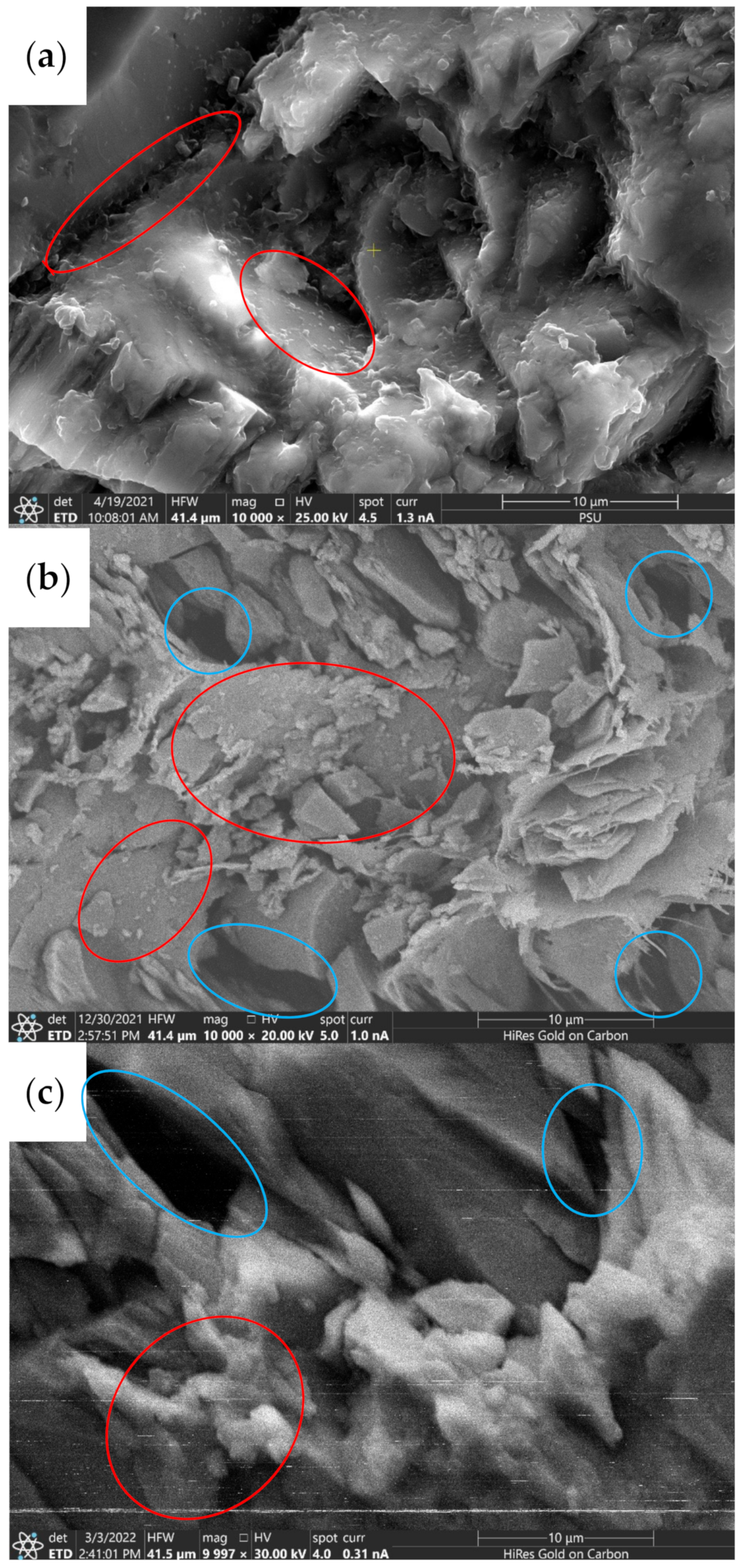
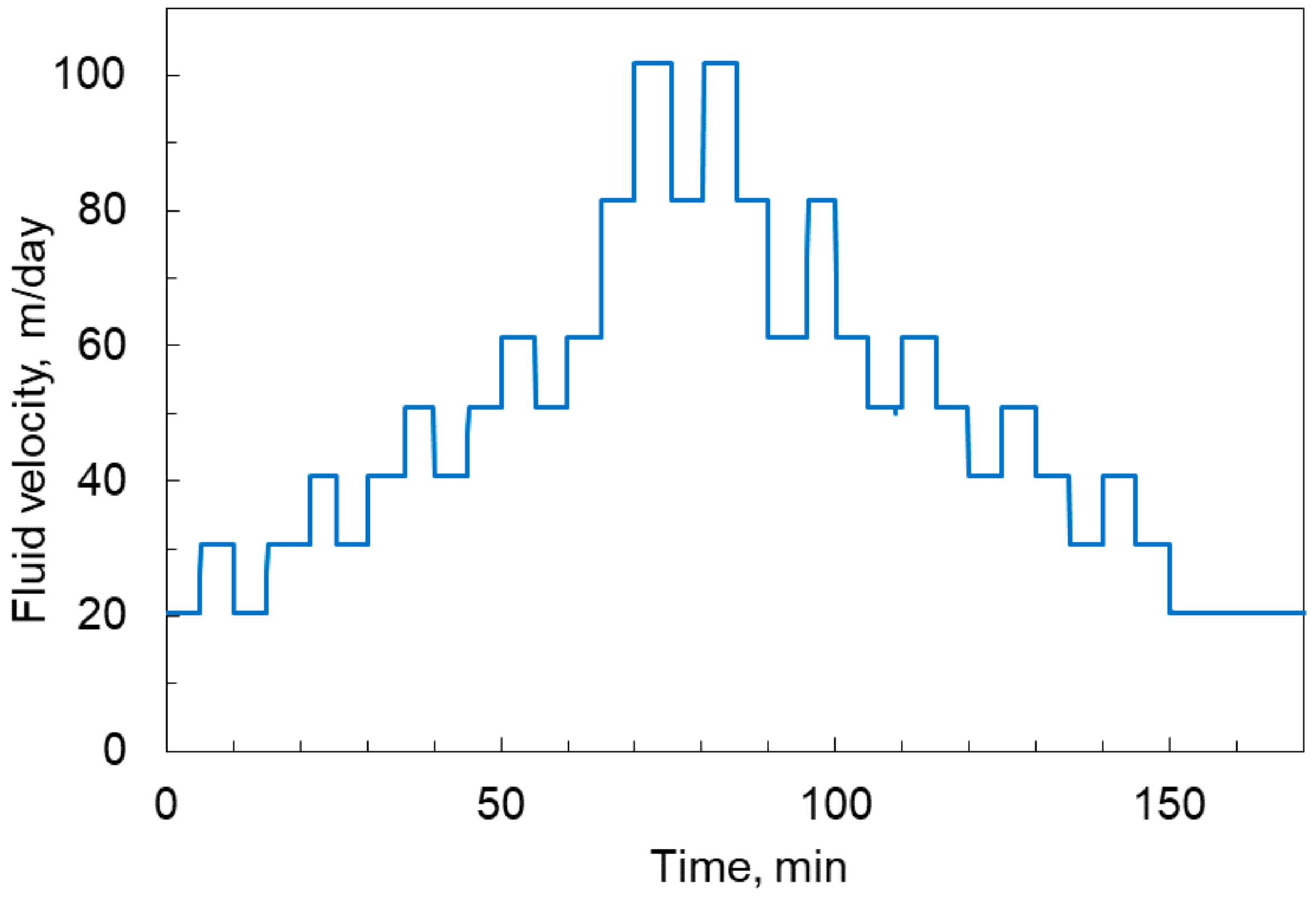

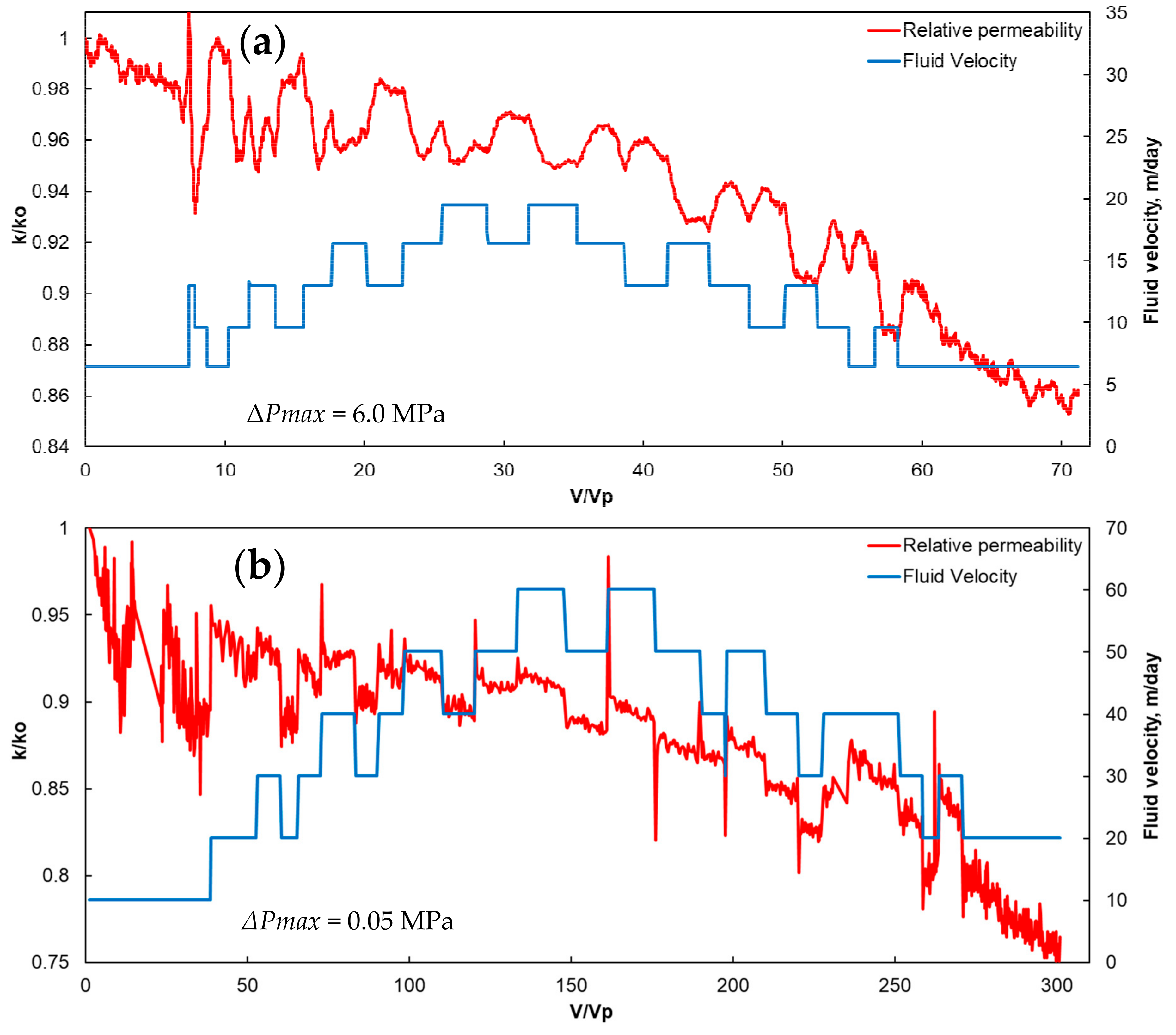

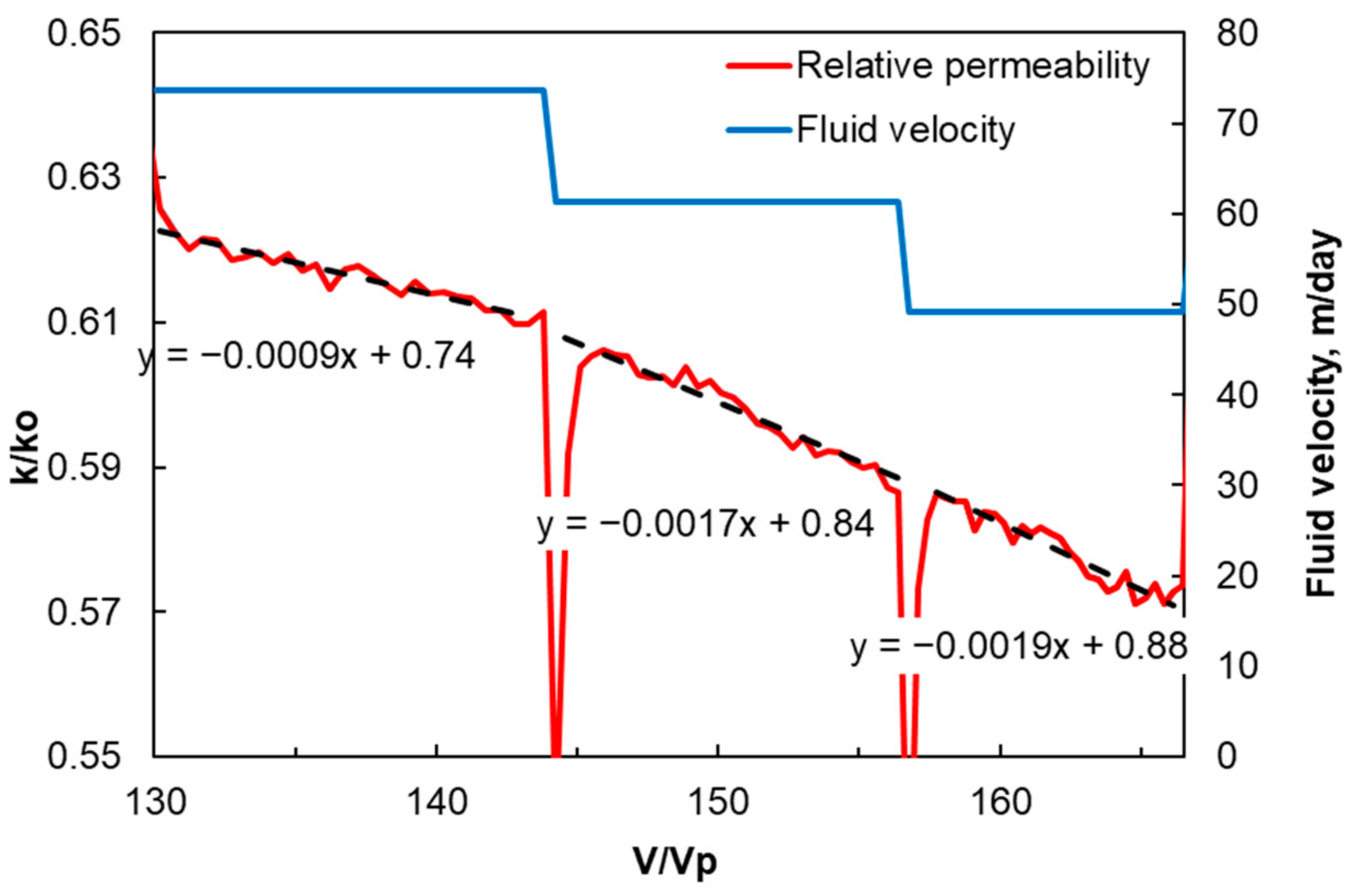
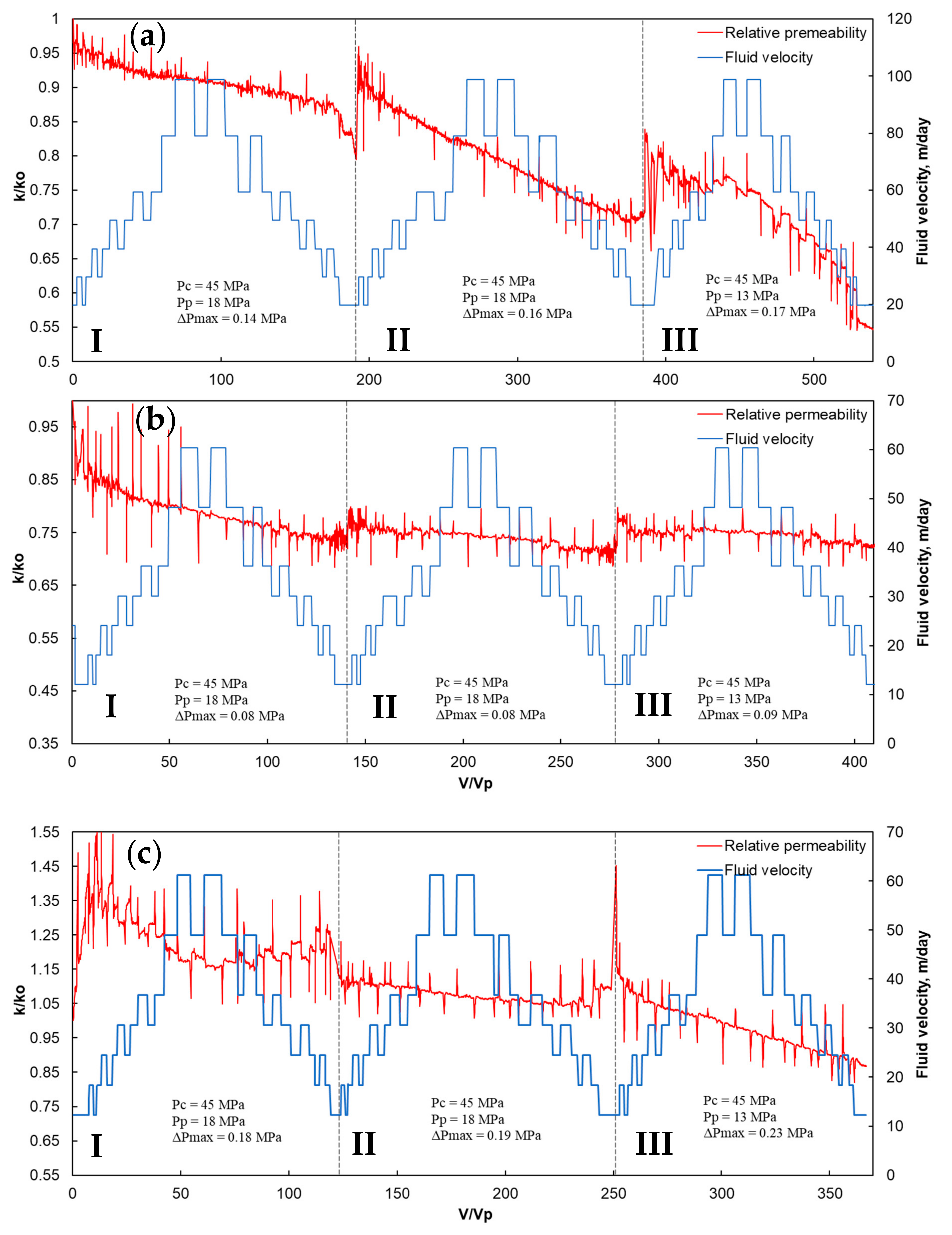
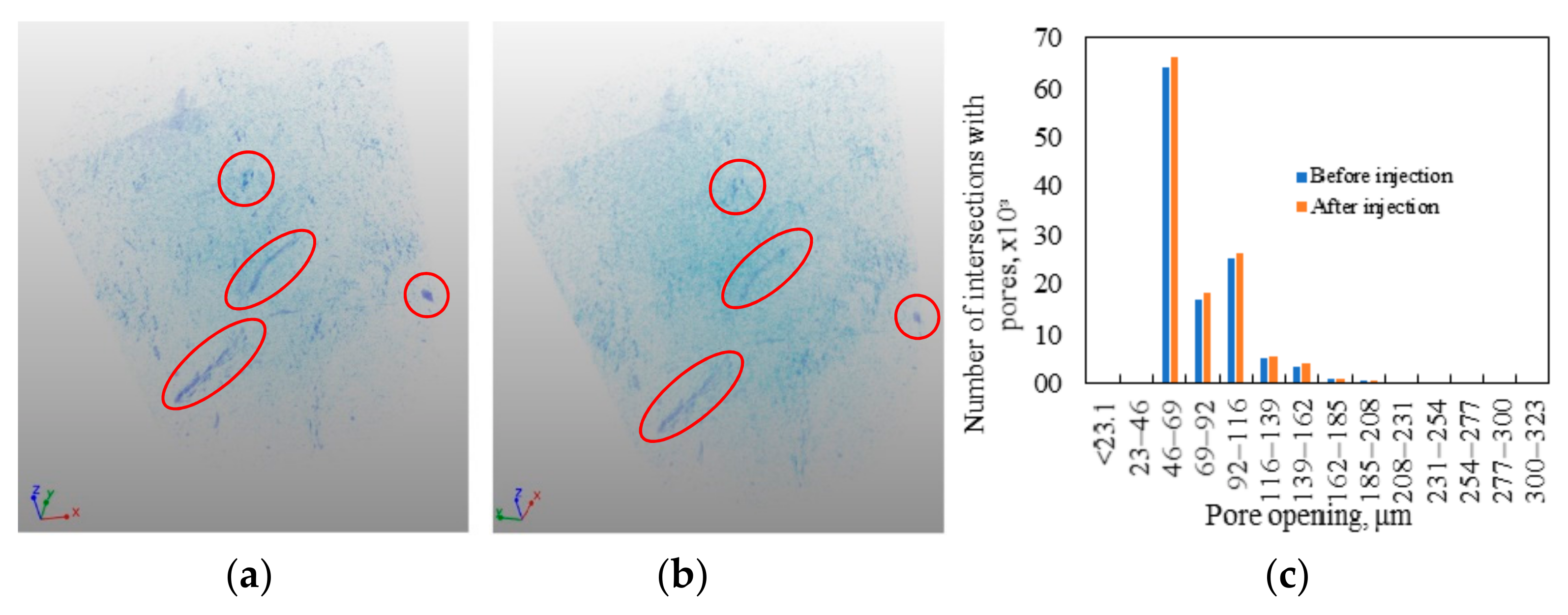
| IGSN | Porosity, % | Absolute Permeability, mD | Fluid Type/Direction of Fluid Flow | Rock Type |
|---|---|---|---|---|
| IEKEV2517 | 7.85 | 0.98 | Deionized water/Forward | Slightly clayey siltstone |
| IEKEV5600 | 10.31 | 47.27 | Kerosene/Forward | Consolidated slightly clayey sandstone (clay content less than 2%) |
| IEKEV5601 | 8.45 | 52.12 | Kerosene/Forward | |
| IEKEV5602 | 8.33 | 27.97 | Deionized water/Forward Kerosene/Reverse | |
| IEKEV7483 | 10.16 | 72.25 | Deionized water/Forward |
Publisher’s Note: MDPI stays neutral with regard to jurisdictional claims in published maps and institutional affiliations. |
© 2022 by the authors. Licensee MDPI, Basel, Switzerland. This article is an open access article distributed under the terms and conditions of the Creative Commons Attribution (CC BY) license (https://creativecommons.org/licenses/by/4.0/).
Share and Cite
Kozhevnikov, E.V.; Turbakov, M.S.; Gladkikh, E.A.; Riabokon, E.P.; Poplygin, V.V.; Guzev, M.A.; Qi, C.; Kunitskikh, A.A. Colloid Migration as a Reason for Porous Sandstone Permeability Degradation during Coreflooding. Energies 2022, 15, 2845. https://doi.org/10.3390/en15082845
Kozhevnikov EV, Turbakov MS, Gladkikh EA, Riabokon EP, Poplygin VV, Guzev MA, Qi C, Kunitskikh AA. Colloid Migration as a Reason for Porous Sandstone Permeability Degradation during Coreflooding. Energies. 2022; 15(8):2845. https://doi.org/10.3390/en15082845
Chicago/Turabian StyleKozhevnikov, Evgenii V., Mikhail S. Turbakov, Evgenii A. Gladkikh, Evgenii P. Riabokon, Vladimir V. Poplygin, Mikhail A. Guzev, Chengzhi Qi, and Artem A. Kunitskikh. 2022. "Colloid Migration as a Reason for Porous Sandstone Permeability Degradation during Coreflooding" Energies 15, no. 8: 2845. https://doi.org/10.3390/en15082845






